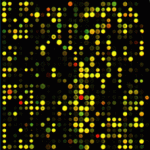Genomics
|
18 november 2014 12:06:55 |
| Transcriptomic analysis of the phytopathogenic oomycete Phytophthora cactorum provides insights into infection-related effectors (BMC Genomics) |
|
Tweet Background:
Phytophthora cactorum, a hemibiotrophic oomycete pathogen, can cause destructive diseases on numerous crops worldwide, leading to essential economic losses every year. However, little has been known about its molecular pathogenicity mechanisms. To gain insight into its repertoire of effectors, the P. cactorum transcriptome was investigated using Illumina RNA-seq.
Results:
We first demonstrated an in vitro inoculation method that can be used to mimic natural cyst germination on host plants. Over 28 million cDNA reads were obtained for five life cycle stages (mycelium, sporangium, zoospore, cyst and germinating cyst) and de novo assembled into 21,662 unique genes. By comparisons with 11 public databases, 88.99% of the unique genes were annotated, including 15,845 mapped to the gene models of the annotated relative Phytophthora infestans. Using TribeMCL, 5,538 gene families conserved across P. cactorum and other three completely sequenced Phytophthora pathogen species were determined. In silico analyses revealed that 620 P. cactorum effector homologues including 94 RXLR effector candidates matched known or putative virulence genes in other oomycetes. About half of the RXLR effector candidates were predicted to share a conserved structure unit, termed the WY-domain fold. A subset of the effector genes were checked and validated by PCR amplification. Transcriptional experiments indicated that effector genes were differentially expressed during the life cycle and host infection stages of P. cactorum. Ectopic expression in Nicotiana benthamiana revealed that RXLR, elicitin and NLP effectors can trigger plant cell death. These effectors are highly conserved across oomycete species. Single nucleotide polymorphisms for RXLR effectors were detected in a collection of P. cactorum isolates from different countries and hosts.
Conclusions:
This study demonstrates the comprehensive sequencing, de novo assembly, and analyses of the transcriptome of P. cactorum life cycle stages. In the absence of genome sequence, transcriptome data is important for infection-related gene discovery in P. cactorum, as demonstrated here for the effector genes. The first look at the transcriptome and effector arsenal of P. cactorum provides valuable data to elucidate the pathogenicity basis of this broad-host-range pathogen. |
| 312 viewsCategory: Genomics |
 Deciphering the heterogeneity in DNA methylation patterns during stem cell differentiation and reprogramming (BMC Genomics) Deciphering the heterogeneity in DNA methylation patterns during stem cell differentiation and reprogramming (BMC Genomics)Meta-analysis of human methylation data for evidence of sex-specific autosomal patterns (BMC Genomics) 
|
| blog comments powered by Disqus |
MyJournals.org
The latest issues of all your favorite science journals on one page
The latest issues of all your favorite science journals on one page



